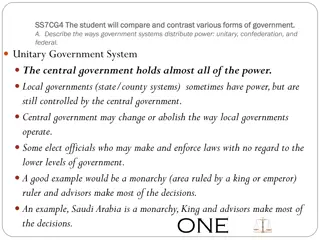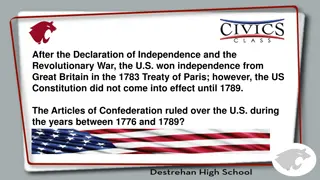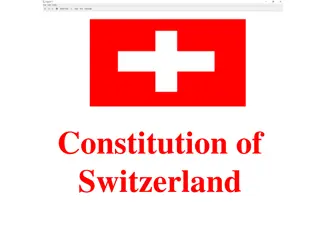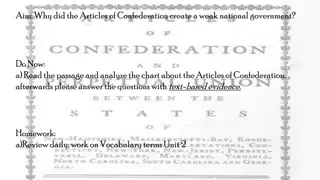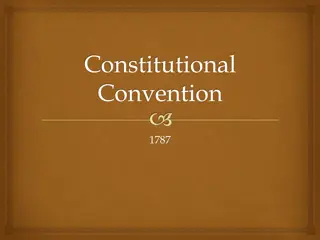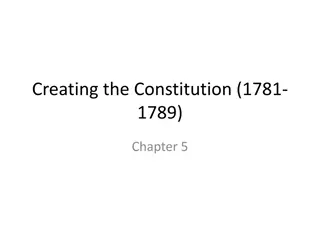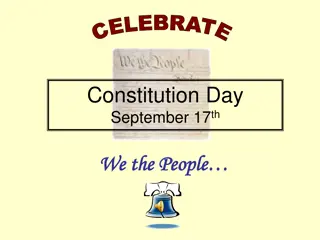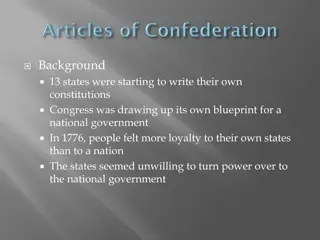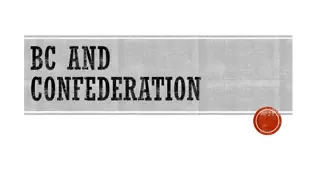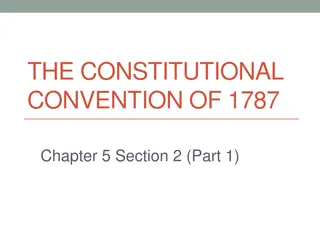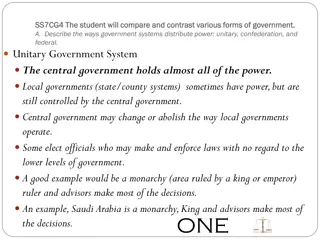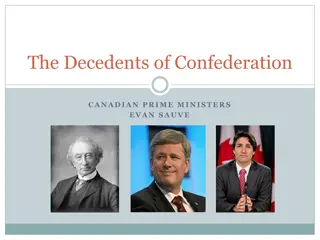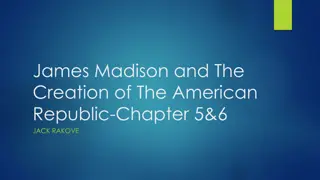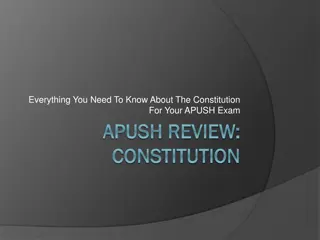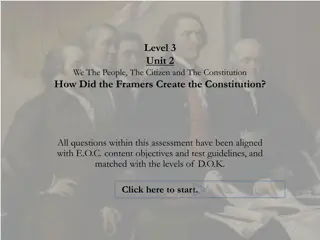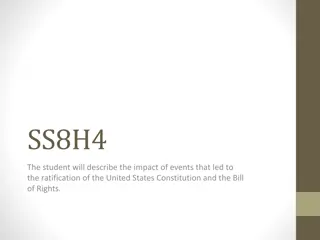Shaping a New Nation: Challenges of the Articles of Confederation
Americans initially adopted the Articles of Confederation as their first government, but soon realized its weaknesses. The lack of a strong central authority, debate over power distribution, limitations on the national government's powers, and challenges in governing newly acquired lands were key is
2 views • 42 slides
Comparison of Government Systems: Unitary, Confederation, and Federal
The comparison of unitary, confederation, and federal government systems highlights how power is distributed between central and local authorities. In a unitary system, the central government holds most power, while local governments have limited autonomy. In confederation, local governments retain
0 views • 37 slides
Evolution from Articles of Confederation to U.S. Constitution
Following the Revolutionary War, the U.S. initially operated under the Articles of Confederation, which provided for a weak central government. However, due to issues such as financial problems and Shays' Rebellion, the Constitutional Convention was called in 1787. This led to the creation of the U.
0 views • 8 slides
Evolution of the Constitution in Switzerland
The Republic of Switzerland, a federal republic with 26 cantons, has evolved through three major constitutions - 1848, 1874, and 1999. Over the years, Switzerland has seen significant changes in its political structure, moving from a confederation to a federation and embracing unique features like D
0 views • 18 slides
Understanding the Weaknesses of the Articles of Confederation
The Articles of Confederation established a weak national government by creating a structure with significant limitations. The central government had no executive or judicial branches, lacked the power to collect taxes, and faced challenges in making decisions and enforcing laws. States held conside
0 views • 15 slides
The Berlin Revolutions of 1848: A Historic Perspective
The Berlin Revolutions of 1848 were part of a series of widespread uprisings across Europe, driven by a mix of liberal and working-class goals. The revolutions aimed to challenge the existing autocratic political structure in the German Confederation and the Austrian Empire. Despite initial hopes fo
1 views • 14 slides
The Constitutional Convention of 1787 and the Birth of the American Constitution
The Constitutional Convention of 1787 was convened to address the weaknesses of the Articles of Confederation and create a stronger central government. Delegates like George Washington, James Madison, and Alexander Hamilton played key roles in drafting the Constitution, which required ratification b
0 views • 5 slides
Evolution of Governance in the United States: Shays' Rebellion to the Constitutional Convention
Shays' Rebellion, led by Daniel Shays in 1786-1787, highlighted the weaknesses of the Articles of Confederation, prompting the Constitutional Convention in 1787. Despite challenges and delays, key figures like James Madison and George Washington played significant roles in shaping the new governance
0 views • 11 slides
Forming the United States: From Colonies to a New Government
Explore the journey of the 13 colonies as they came together to form the United States of America. Learn about the creation of the Constitution, the fears of the founders regarding the abuse of power, and the transition from the weak Articles of Confederation to a stronger central government followi
0 views • 29 slides
American Revolutionary Era: Key Events and Figures
The American Revolutionary Era marked by the formation of the Constitution, Washington's militia, key figures like Jonathan Trumbull and John Peter Muhlenberg, the emergence of American culture, the Articles of Confederation, and calls for a stronger government. This period saw a shift towards a mor
0 views • 17 slides
The Evolution of Governance in the United States (1781-1789)
This chapter explores the pivotal period from 1781 to 1789 in US history, focusing on the creation of the Constitution. It covers the challenges of the Articles of Confederation, the legislative branches, freedom of religion controversies, financial weaknesses, events like Shays' Rebellion, and the
0 views • 30 slides
Strengthening Tea Smallholders Sector: Challenges and Solutions
Tea smallholders play a crucial role in the global tea sector, facing challenges like price realization and quality standards. Efforts such as the Confederation of International Tea Smallholders (CITS) aim to address these issues by providing a platform for policy development, market access, communi
0 views • 12 slides
Challenges in Promoting Collective Bargaining and Fighting Anti-Union Busting
The European Trade Union Confederation (ETUC) highlights the importance of the Directive on adequate minimum wages in the EU to combat union busting practices. While the Directive addresses some demands related to promoting collective bargaining, there is a need for further strengthening to effectiv
1 views • 13 slides
The Evolution of U.S. Government: From Declaration of Independence to Constitution
The journey from the Declaration of Independence in 1776 to the Constitutional Convention in 1787 marked a crucial phase in American history. Beginning with the assertion of unalienable rights to the creation of a more effective and legitimate government through the Great Compromise, this period sha
0 views • 17 slides
Celebrate Constitution Day: A Brief History of the U.S. Constitution
Learn about the significance of Constitution Day on September 17th and the journey that led to the creation of the U.S. Constitution. From the challenges posed by the Articles of Confederation to the final signing of the Constitution, delve into the key events and figures that shaped the foundation
0 views • 8 slides
Understanding the European Union: Benefits and Structure
The European Union (EU) is a confederation where member countries work together for mutual advantages, such as increased competitiveness in the world market. While the EU does not handle all government functions, it offers benefits like a common currency (Euro) for easy trade and the freedom of move
0 views • 18 slides
Addressing the Cash Crisis and Informal Economy in Zimbabwe
The presentation by Miss Rosemary Siyachitema at the Confederation of Zimbabwe Retailers Breakfast Meeting highlighted the challenges of the ongoing cash crisis in Zimbabwe. Major causes include the introduction of Bond Notes and Statutory Instruments, dependency on foreign currency, declining inves
0 views • 7 slides
Health and Care LGBTQ+ Inclusion Framework Briefing for Board Members
The Health and Care LGBTQ+ Inclusion Framework, developed by the NHS Confederation's Health and Care LGBTQ+ Leaders Network, aims to address the heightened risks faced by LGBTQ+ workforce members in the healthcare sector. It emphasizes creating inclusive cultures through visible leadership, staff su
1 views • 15 slides
Challenges in Crafting the Articles of Confederation
Thirteen states were crafting their own constitutions, while Congress aimed to establish a national government in 1776. Loyalty to states over a nation hindered power transfer to the national government. Land disputes and state refusals delayed the ratification of the Articles of Confederation, lead
0 views • 10 slides
Challenges and Choices in British Columbia's History
British Columbia faced economic challenges post the Gold Rush, leading to a consolidation of colonies and increasing debt. The united colony explored options of Confederation, maintaining British colonial status, or annexation by the US, driven by different groups with varied interests. This histori
0 views • 10 slides
The Constitutional Convention of 1787: Key Plans and Compromises
The Constitutional Convention of 1787 aimed to address issues with the Articles of Confederation by considering the Virginia and New Jersey Plans. The Great Compromise led to the formation of a bicameral Congress with proportional representation in the House of Representatives and equal representati
0 views • 17 slides
Extractive Industries Transparency and Accountability Workshop in Zanzibar
The workshop organized by the East African Trade Union Confederation addressed the challenges and opportunities in the extractive industries sector in Africa, focusing on the essence of Publish What You Pay (PWYP) and the Extractive Industries Transparency Initiative (EITI). It discussed the resourc
0 views • 54 slides
Comparison of Unitary, Confederation, and Federal Government Systems
The unitary government system centralizes power in the central government, confederation delegates power to local governments, and federal shares power between levels of government. Examples like Saudi Arabia (unitary), confederation (decentralized power), and the USA (federal) showcase these system
0 views • 36 slides
National Confederation of Disabled People (NCDP) Initiatives for Disability Inclusion and Accessibility
The National Confederation of Disabled People (NCDP) plays a crucial role in promoting disability rights and accessibility in Greece by actively engaging in the implementation of European Structural and Investment Funds. Through their involvement in policy development, training initiatives, and advo
0 views • 9 slides
The Decedents of Confederation: Canadian Prime Ministers
Explore the history of Canadian Prime Ministers such as Sir John A. Macdonald, Alexander Mackenzie, Sir John Abbott, Sir John Sparrow David Thompson, Sir Mackenzie Bowell, and Sir Charles Tupper. Learn about their contributions, backgrounds, and political legacies in shaping Canada as a nation.
0 views • 29 slides
Understanding Government Systems and Divisions of Power
Explore the various divisions of power in government systems worldwide, with a specific focus on the U.S. Understand the concepts of federal, unitary, and confederation states, and learn about the structure of the U.S. government with its separation of powers and checks and balances. Discover how ge
0 views • 17 slides
Evolution of American Governance: From Articles of Confederation to Constitutional Convention
Explore the transition from the Articles of Confederation to the Constitutional Convention shaped by assumptions about government after the Revolution. Discover how James Madison identified problems with the Articles, leading to key issues like representation, federalism, executive responsibilities,
0 views • 11 slides
Understanding the Constitution for Your APUSH Exam: Key Points & Compromises
The Constitution was born out of the need to address the weaknesses of the Articles of Confederation. Key compromises like the Great Compromise and the 3/5 Compromise shaped its structure. Issues such as a weak central government and economic challenges were tackled through the ratification process.
0 views • 8 slides
SANIMART Virtual Exposition: Innovations for Safe Workspaces in the COVID-19 Era
The SANIMART virtual exposition organized by the Confederation of Indian Industry aims to showcase innovations in the sanitation and personal hygiene space to combat the challenges posed by the COVID-19 pandemic. From sanitization industry products to technology applications, safety equipment, COVID
0 views • 14 slides
Weaknesses of the Articles of Confederation and Land Policies Explained
The weaknesses of the Articles of Confederation, including the lack of provision for adding new states, the Land Ordinance of 1785, and the Northwest Ordinance of 1787, are explored. The reasons behind these weaknesses are discussed, shedding light on the challenges faced by the early American gover
0 views • 8 slides
Exploring ECPCP: Who We Are, How We Work, and Our Future Vision
Discover the European Confederation of Primary Care Paediatricians (ECPCP), its history, leadership, growth, and meetings. Learn about the challenges faced in certain countries and the unique position of ECPCP as an independent association with strong relationships to other healthcare organizations.
0 views • 25 slides
The Evolution of American Governance
Explore the foundational principles leading to the American Constitution, highlighting key factors such as independence, natural rights, grievances against British rule, and the shortcomings of the Articles of Confederation. The visual content illustrates the journey towards a more effective system
0 views • 28 slides
Understanding the Formation of the Constitution
Exploring the Articles of Confederation, confederation systems, and insights from George Washington regarding government energy in establishing the Constitution.
0 views • 77 slides
The Impact of Georgia's Role in the Constitutional Convention of 1787
Georgia played a significant role in the Constitutional Convention of 1787, influencing the Three-Fifths Compromise and the Great Compromise. The involvement of Georgian delegate Abraham Baldwin led to the bicameral legislative branch of the government. The writings of William Pierce offer valuable
0 views • 16 slides

